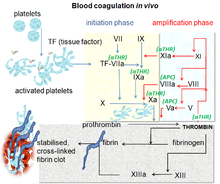Coagulation is seen as the process of making blood clot. It is an important and complex process that allows the blood to plug and heal a wound. And the body stops any unwanted bleeding. Coagulation usually involves the action of cells and coagulation factors. The cells are platelets, and the coagulation factors are proteins. These proteins are present in the blood plasma and on the surfaces of certain vascular, or blood vessel, cells. For instance, If a person’s blood clots too much, they may develop deep vein thrombosis (DVT) and other problems. And If it does not clot enough, a person can have hemophilia. In this situation, bleeding happens too easily.
How Coagulation Happens
Nosebleeds can easily occur when a person has hemophilia. Hemostasis is the process which stops bleeding and prevents damaged blood vessels from losing too much blood. Coagulation is an important part of hemostasis. In hemostasis, platelets and a protein referred to as fibrin work together to plug a damaged blood vessel wall. This stops the bleeding and gives the body the opportunity to repair the damage.
When damage happens in the endothelium, which is the lining of a blood vessel, platelets immediately form a plug at the site of the injury. At that time, proteins in the blood plasma respond to form fibrin strands. In a more complex chemical reaction, these strands form and reinforce the platelet plug. As the platelets gather at the site of an injury to plug, or block it, the coagulation factors act in a variety of chemical reactions to strengthen the plug and healing to begin.

Meaning Of Platelet
Platelet as a disc-shaped element in the blood which plays a role in blood clotting. During normal clotting, platelets clump do come together. And Platelets are blood cells which come from megakaryocytes, these are cells that the bone marrow produces.
Meaning Of Fibrin
Fibrin is seen as an insoluble protein that plays a role in blood clotting. Fibrin gathers around the wound in a mesh-like structure that strengthens the platelet plug. As this mesh dries and hardens, or coagulates, the bleeding pauses and the wound then heals.
Therefore, In conclusion, the process of the mechanism of coagulation usually involves activation, adhesion, and aggregation of platelets inline with deposition and maturation of fibrin. The most important aspect is that disorders of coagulation can lead to bleeding (hemorrhage or bruising) or obstructive clotting (thrombosis).